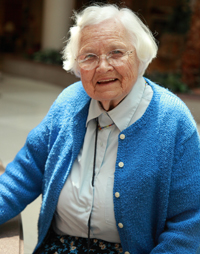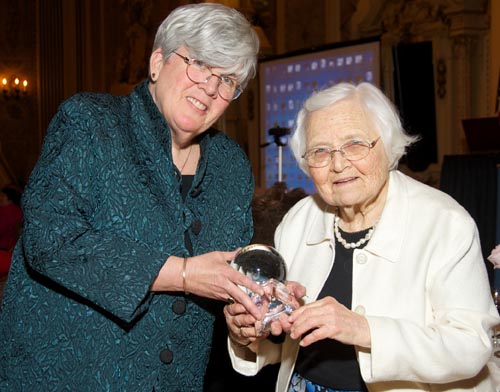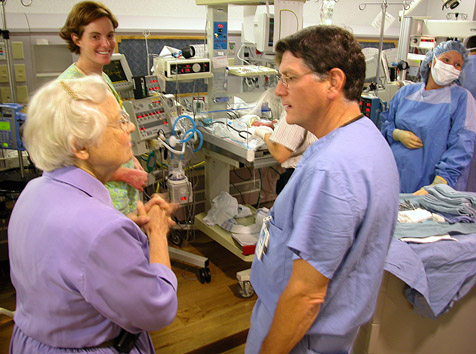Q&A: Dr. ‘Kitty’ Esterly still advocates for all of Delaware’s newborns


Katherine L. Esterly, M.D., retired chair of Christiana Care’s Department of Pediatrics and a pioneer in neonatology, received the Delaware Academy of Medicine’s President’s Award at the Academy’s annual meeting, April 18. The academy bestowed the additional honor of naming a new annual conference on childhood development for Dr. Esterly, held April 20 at the John H. Ammon Medical Education Center. Dr. Esterly’s career at Christiana Care spanned six decades, from her residency at then Delaware Hospital that began in 1952 to her retirement in 2004.
Q: What is your message to friends and colleagues on the occasion of these Delaware Academy of Medicine honors?

A: The development of a child begins at birth. It’s important that we give the best we can from the very beginning. Every child, rich or poor, needs support, whether born at full term or prematurely.
We’ve had a big change in the status of the family over last 50 years. We are about three generations away now from the day when families would usually have a mom who stayed at home. Now we think we have to have two earners, and the care of our babies in daytime is done by somebody who is expensive and probably inexperienced.
Day care is very important, but we must also teach parents how to nurture their children, paying special attention to environmental factors in the development of the child, consistently until the child is 3 and then again before kindergarten. In Delaware, we are fortunate to have a formalized program called Child Development Watch to assist in this heightened attention.
I was taught as a student that babies didn’t see until six weeks of age. We sure found that wasn’t true! T. Berry Brazelton, M.D., found that babies can see right after they are born. We’ve learned a lot, and there’s a lot more to learn.
Delaware has been lucky to have a lot of interested people who have had an effect on our legislature. I hope we continue to have such people coming out to support our children’s healthy development.
Q: What accomplishments are you most proud of as a neonatologist, pediatrician and department chair?
A: One thing we did well was to develop a neonatal transport team and neonatal nurse-practitioners program. The transport team got off the ground in 1985 after we moved to Christiana Hospital. We had three neonatologists on staff — myself, Dr. Michael L. Spear and Dr. Thomas Young. Dr. Young came to us from a neonatology fellowship at the University of Virginia where they had a nurse transport team.
Today I believe we are much more successful serving babies coming from other hospitals in the state. They used to arrive inconsistently warmed, and often not breathing well. Now they arrive in much better condition. Of course, the mother is the best transport system we have. Preventing premature birth is our first goal. I think the outlying hospitals we serve are becoming better attuned to that.
Q: How did the neonatal nurse program start?
A: There will always be babies who come in to the nursery after the delivery. In the early days at the General Division and the Delaware Division, as part of the Medical Center of Delaware, and later at Christiana Hospital, we found increasing demand for skilled people to stabilize the babies and take care of them. We had pediatric residents, but they were unable to do all the work, so we had to have nurse practitioners. The first two neonatal nurse practitioners were master’s-degreed clinicians sent to Georgetown University Hospital for post-master’s didactic training, who then returned to our nursery and learned to do highest-level clinical care and procedures. They are Susan Imam, MS, NNP-BC, now manager of the neonatal nurse practitioners at Christiana Care, and Lynn Bayne, Ph.D, NNP-BC, who still works part time for us and does clinical research.
After serving as a pediatrician and later as a board-certified neonatologist for more than 40 years, I became chair of Pediatrics in 1994 and retired in 2007. During that time there was a reduction in the number of hours that residents could work, so our nurses and nurse practitioners had to fill the gap. Now I think we are approved for 24 neonatal nurse practitioners, and we currently have 23.

Q: What is your view of family involvement in the special care nursery?
A: It’s much more important now than it was 50 years ago, as long as everyone practices proper hand-washing. When I first started out in the Delaware Hospital, mothers weren’t even allowed to go in in the preemie nursery. We were very afraid of infection. We couldn’t give antibiotics very well. Then technology came along and we could deliver antibiotics. To prevent infection, Dr. Margaret Handy taught us how to do proper nursing care, to put on a cap and gown and scrub up to the elbows, like a surgical scrub. We learned later that hand washing was really the key. The nursery staff was diligent but the consultants who came in — sometimes you had to smack their hands to remind them.
Q: Were you involved in a lot of research?
A: While developing the nursery, most research was done in other places, and we would pick up on it and learn from it. Later we began to do more research with partners, such as the University of Delaware. For example, we helped prove that babies do much better in an environment of quiet and low-intensity light, so we received much more space and were better able to emphasize those factors. For a while our nursery, which was designed by John Stefano, M.D., was thought to be the most up-to-date nursery in the country. But I think we’ll need more space again soon because the family needs to be more intensely involved in the baby’s care, and that requires more room.
Q: What other developments or issues still draw your interest?
A: One thing that interests me is infant head-cooling technology for babies with low Apgar scores. The discussion about this technology really gained attention from the clinical community as a brain and life-saving measure in 2007. Term babies who have low Apgar scores are carefully screened during the first six hours of life and if they meet criteria are cooled to slow their brain and body metabolism for the first three days of life. Another lifesaving program has been the Christiana Care Pediatric Hospitalists program, which allowed fully trained pediatricians to care for our babies and children while they are inpatients in labor and delivery, in collaboration with the private pediatricians in the community.
Another area that interests me is the importance of mother’s breast milk. We’ve known for a long time that mother’s milk was best for the baby — and premature babies. The Mother’s Milk Bank, which was started by Dr. Handy, is still one of the best systems, but it’s pretty old. I’ll be interested in seeing what the future brings. Ours was among the first five milk banks in the country, and it came about because of a Junior Board member, Mrs. Margaret Trentman. After she had her baby, she couldn’t produce her own milk and her baby couldn’t tolerate formulas. She found a milk bank in Boston and that is how we got started.
After the Mother’s Milk Bank started, we knew our babies were not having as much of the intestinal problems as other hospitals. Still, a lot of people back then thought it was a lot of bunk. Now nurseries everywhere want a supply of mother’s milk, and 60 – 70 percent are producing it in the nursery. We have a milk lab to take care of the milk and formulas for all the babies in the nursery, in sterile condition.